Founded 81 years ago, Patro Eisden have never featured in the top flight of Belgian football, with the club normally appearing in the second division of Belgian football. However, recently the club were in a bit of a poor situation, with them being relegated from the second division at the end of the 2004/05 season. Due to the fact that the club also did not have a license, it was renamed to its current name for the 2005/06 season and plied their trade in the fourth division.
After a long wait, the club is back in the second division, with them being promoted to the Challenger Pro League after winning the Belgian National Division 1 at the end of last season. A lot of the credit can go to former Club Brugge goalkeeper Stijnn Stijnen, with the 42-year-old guiding the club back to the second division after being in charge since 2018.
So far, after five matchdays, Patro Eisden have been brilliant, with the club sitting third, only two points behind Manchester City group club Lommel. They also are the second-highest scorers in the division, showing that they have not had trouble making the jump up a level from an attacking standpoint. This tactical analysis will take a look at a couple of Stijnen’s tactics, analysing them in detail and showing why they have been so successful in this young season so far.
Preferred formation and lineup
Five matchdays into the new Challenger Pro League season, and Stijnen has seemed to have found a couple of preferred formations, namely either a 4-4-2 or a 4-2-3-1. While he seems to have found his formations of choice, the same can not be said about all of the personnel. While the goalkeeper and backline have been unchanged, there has been more rotation from the Belgian in the midfield and attacking positions throughout the beginning of this season.
However, through five games, Stijnen has been pretty consistent in his choice of starting XI, with the Belgian having a very experienced player added to his ranks in veteran Belgian footballer Stef Peeters. The 31-year-old has played for multiple clubs in Belgium, including Genk, Sint-Truiden, Zulte-Waregem, Cercle Brugge, and Eupen. The midfielder joined as a free agent this summer and has already made a pretty quick impact for the Belgian side.
In fact, he made his first appearance for the club in Patro Eisden’s last match against Anderlecht II, starting as a second striker in a 3-1 win for Stijnen’s side. As this tactical analysis progresses, we will take a closer look at the tactics of Patro Eisden and some of the secrets to their success in the early days of this Challenger Pro League season.
Direct style of play, along with good second ball framing, leads to chance creation
When watching Patro Eisden this season, one trend that begins to stand out is the more direct style of play that Sijn Stijnen has implemented to progress the ball into the attacking third. While they may look to play short in build-up phases initially, the result has normally been a long ball into the opponent’s attacking half, with Patro then looking to either win first contact or frame well for the second ball if they were to lose out to the opposition on the initial long ball.
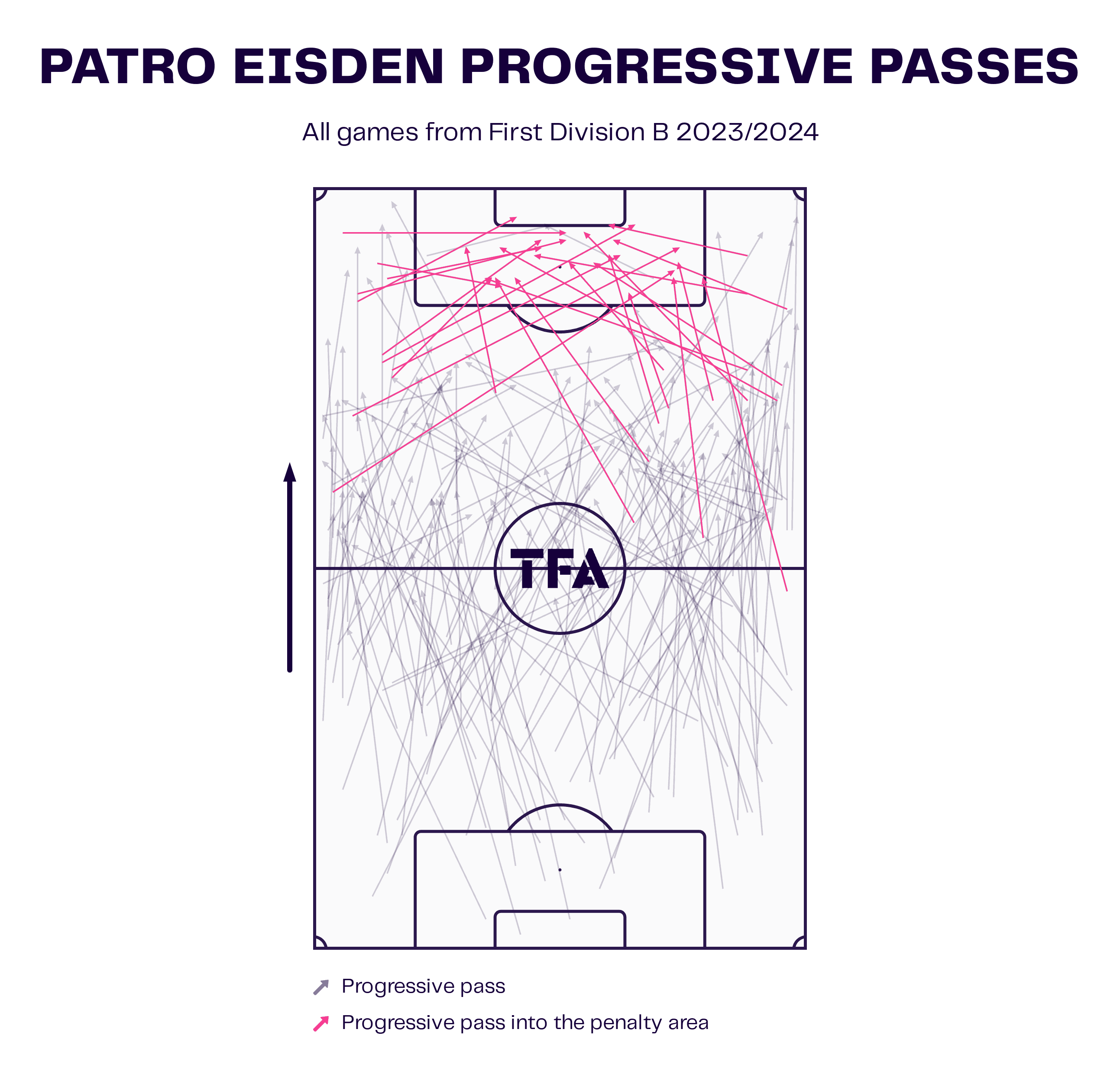
The data viz graphic above looks at all the progressive passes Patro Eisden has played so far in the Challenger Pro League this season. As we can gather from the data, most progressive passes from Stijnen’s side have been long balls from inside the defensive third, typically during build-up phases.
Through the first five games of this new season, Patro have averaged just over 36% possession per match, showing their tendency to not necessarily look to stay on the ball for long during their possession phases. This possession stat is the lowest in the Challenger Pro League, emphasising the more direct style of attack that Stijnen’s side has utilised to relative success this season.
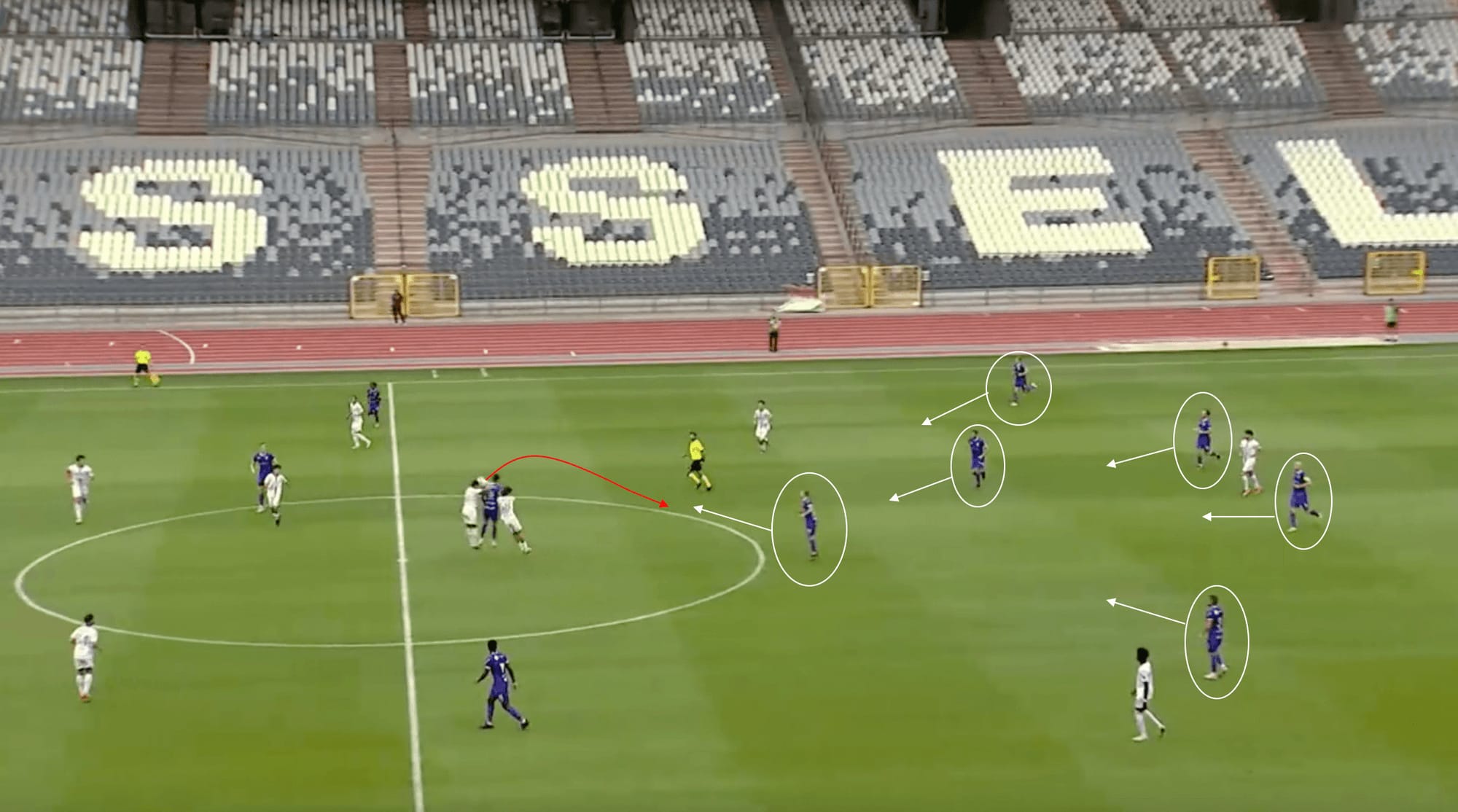
The image above shows an example of a goal kick from Patro Eisden. As this tactical analysis has already mentioned, Patro Eisden are not a side that will look to build play up through their goalkeeper and backline methodically. Instead, they look to play more directly, challenging for first and second balls. This phase of play shows how well they look to frame for the second ball and how quickly they attack after winning possession.
As the ball is played long from the goalkeeper, the intended Patro Eisden player is sandwiched between two Anderlecht II players, making it difficult to win first contact. However, notice how the rest of the Patro players in the defensive half push up into favourable positions for the second ball, framing the midfield area and outnumbering the Anderlecht II players 2-to-1. This puts them as heavy favourites to win the second ball and continue to build quickly into the attacking half, looking to catch the opposition defence out of shape.
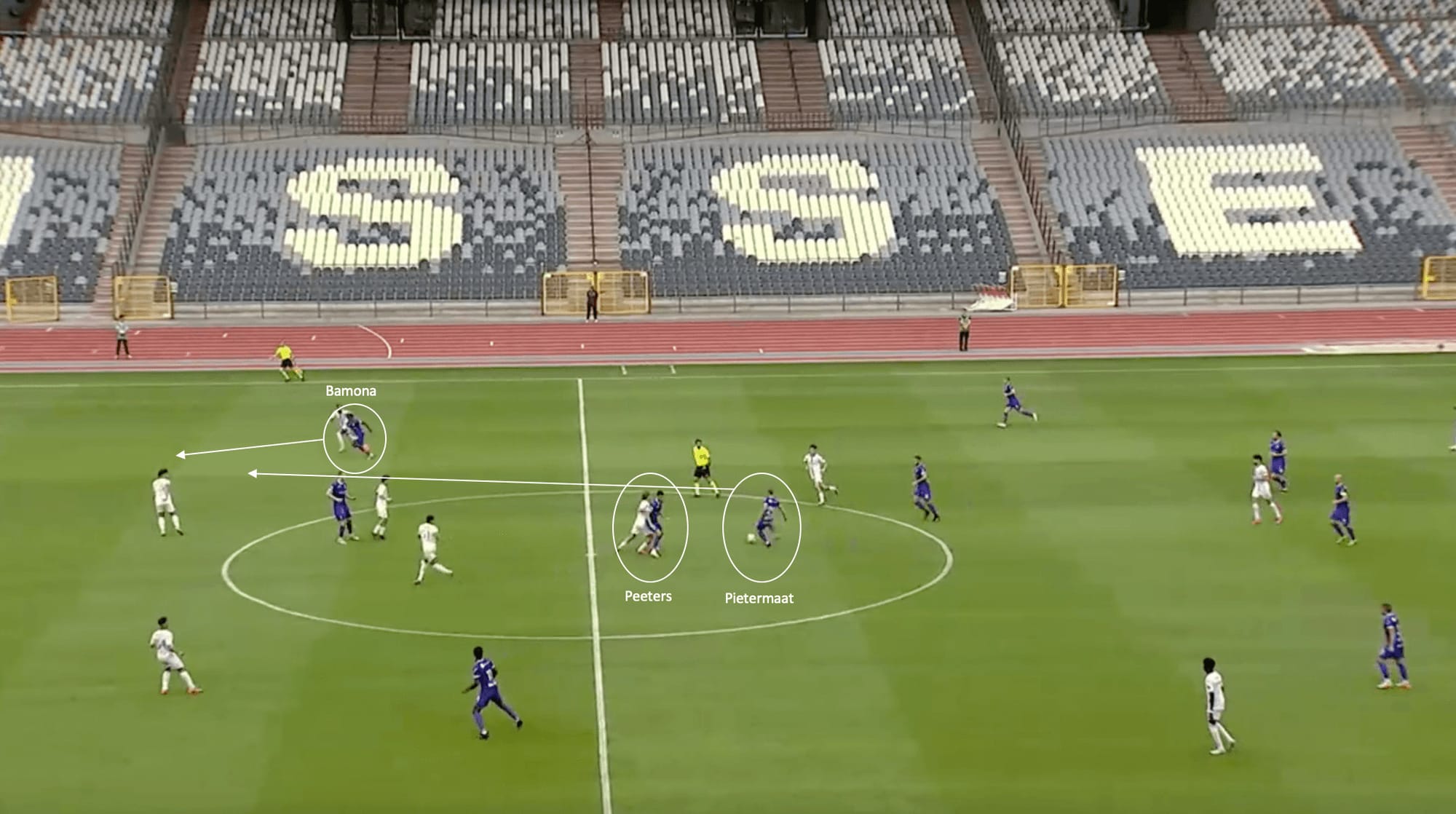
The image above shows the ensuing second ball phase from Patro Eisden. After Stef Peeters fails to win the header and it drops backwards, it falls to the closest-positioned player, Tom Pietermaat, who can receive with no opposition pressure. The opposition defender, who was in front of Peeters during the initial ball, has dropped back to join the defensive shape, leaving only the player who had won the header, putting pressure on the 31-year-old midfielder.
However, Peeters does well to screen him, which gives Pietermaat the ability and time to play a perfectly weighted pass into the path of the wide midfielder, Leslie Bamona. The 30-year-old can run onto the pass and behind the Anderlecht II backline, as the fullback is caught a bit too advanced and on the wrong side of Bamona, allowing the attacker the advantage. As a result, he can drive all the way into the penalty box and get a shot off, though the ‘keeper was not challenged as it hit the side netting.
Though Patro Eisden did not create a shot on target from this attacking move, it shows what they are capable of in this direct style of attack, with framing for the second ball and getting forward in minimal passes critical to Stijnen’s side’s success in the early days of this new Challenger Pro League season.
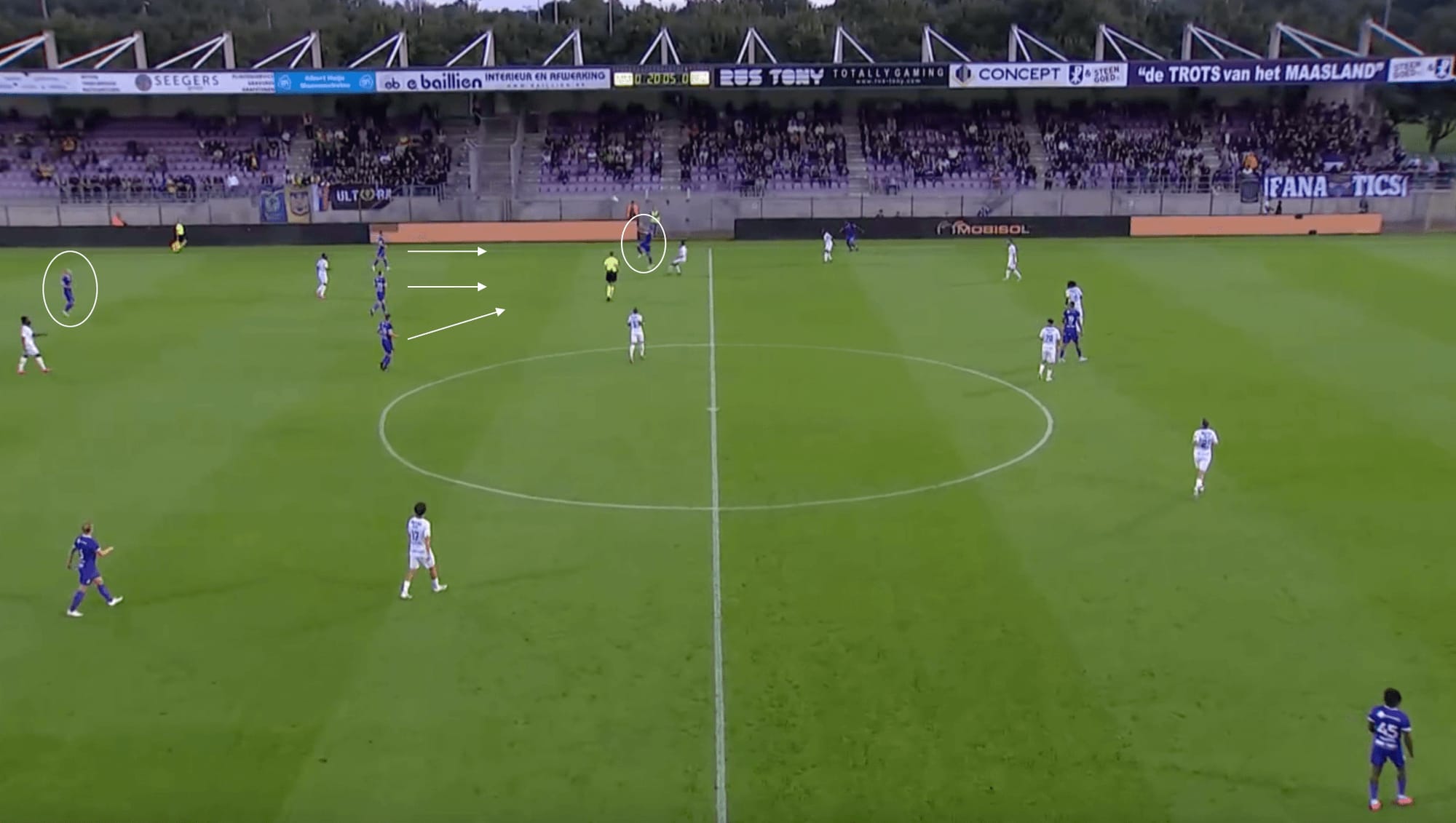
The image above shows another example of how well Patro Eisden looks to frame for the second ball, this time from their recent win against Wim de Decker’s SK Beveren. This phase of play above again originates from a goal kick that is played into the middle third of the pitch. Notice how when the ball is still in the air, the three closest Patro players all look to converge on the space in anticipation of a second ball.
However, the ball is slightly overhit, with the Patro player winning first contact but flicking it forward into the Bevern defence, allowing them to gather possession and begin building. This does still paint a pretty good picture of how Stijn Stijnen’s side reacts when it comes to positioning in the middle third for the second phase.
Their good job of framing the space allows them to screen out the Bevern attacker behind them, making them heavy favourites to win the second phase and continue to play the ball into the attacking third. Also, the circled centre-back, plus the one not in the picture, are able to go man-to-man if the Bevern attacker does gather possession, not leaving them numbers down in a dangerous area of the pitch. All in all, this strategy essentially allows Patro to control the middle third and be able to play dangerous balls forward while also not leaving them exposed in defensive areas of the pitch.
Passive defending and looking to keep the game in front
When it comes to the defensive phase of play for Patro Eisden, they look to defend passively, keeping the ball in front of them and not looking to press in the opposition’s defensive half of the pitch. In fact, Patro Eisden have a passes per defensive action (PPDA) of over 15, the highest in the Challenger Pro League, which highlights their tendency to drop off and look to keep the game in front of them. So far, this defensive strategy has worked, with their seven goals conceded this campaign the joint-third lowest in the Belgian second division.
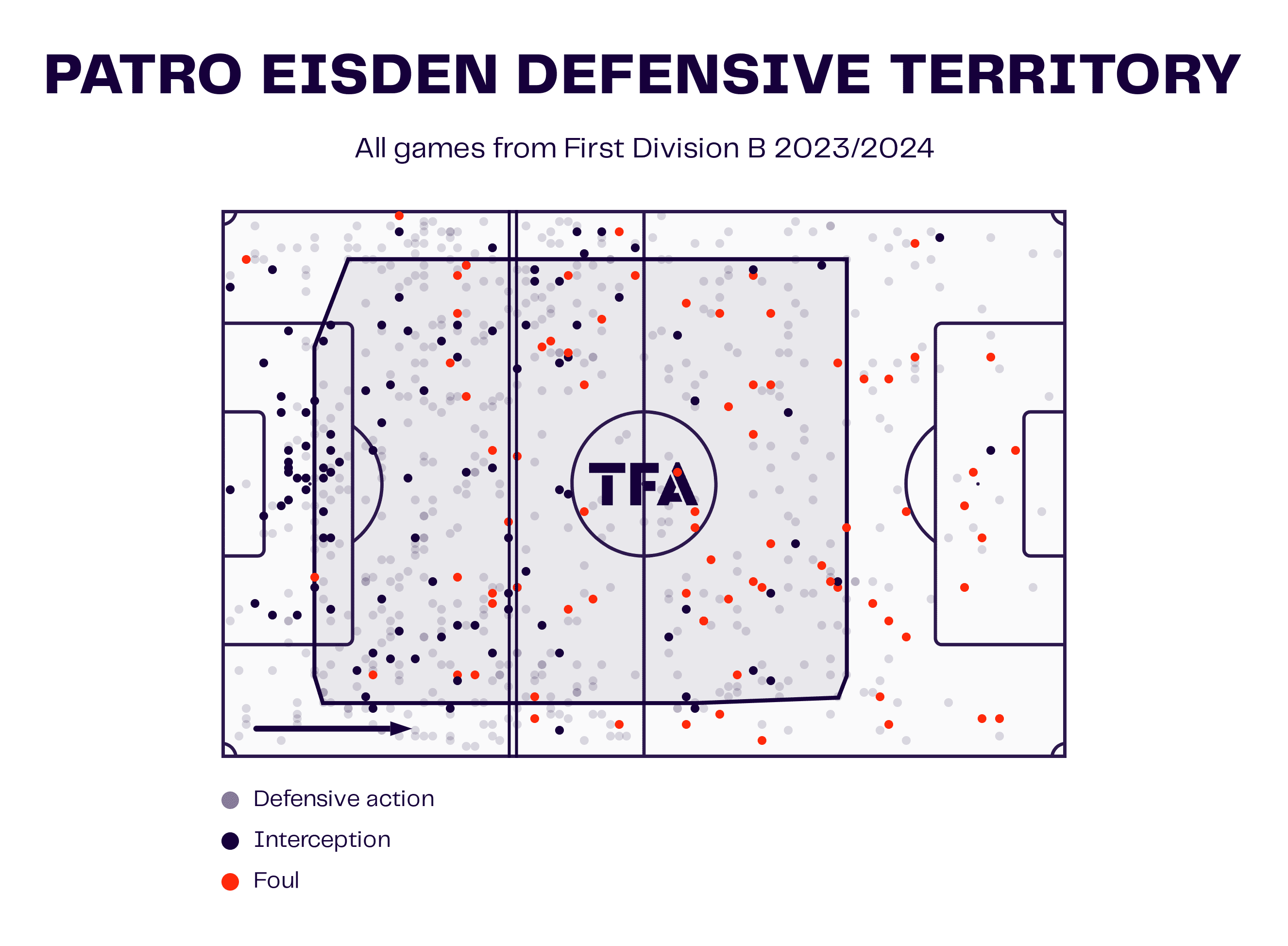
The data viz graphic above shows the defensive territory of Stijn Stijnen’s side this season, showing their average area of engagement as well as the average height of their defensive line. As we can see, the Patro defensive line sits relatively deep, with their line of confrontation being almost halfway into their defensive half.
Another thing to note is the amount of interceptions and defensive actions the Belgian side have had in their penalty box, with only one foul inside the box and two more near this area. This highlights the lack of complacency Patro Eisden shows defensively, with them constantly being on their toes at all times and staying compact as a unit in defensive moments.
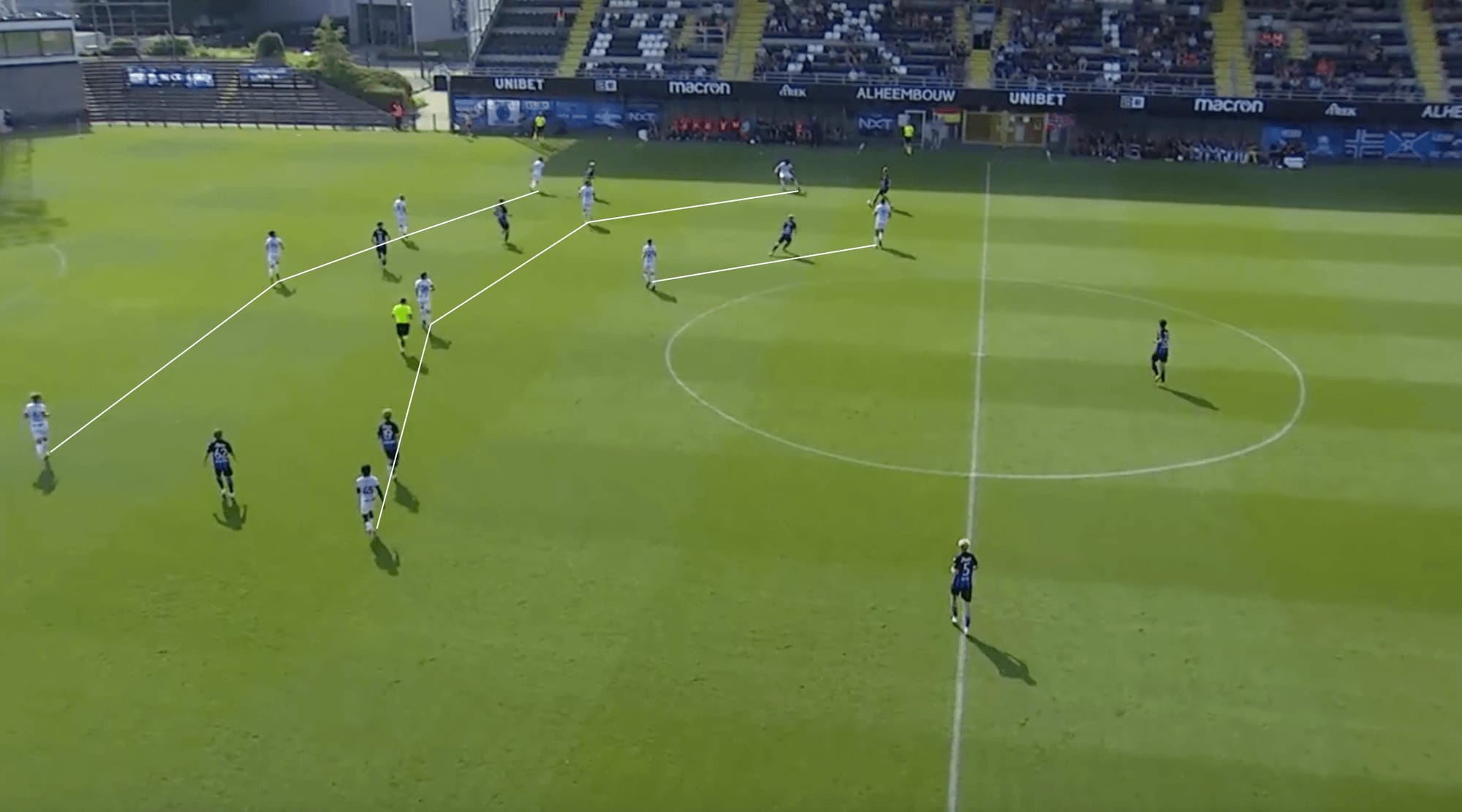
The image above shows the usual defensive shape of Patro Eisden when the opposition sides are in possession. As we can see from this defensive phase, they look to have essentially everyone behind the ball, with one of the strikers potentially staying in front of the ball but still staying in the defensive half. They look to organise in two compact blocks of four, akin to Diego Simeone at Atlético Madrid.
The goal is to frustrate opposition sides, as what happened here against Club Brugge II. As the ball is swung between the defenders, the Patro defence constantly shifts and stays narrow in the central areas, eliminating potential channels for the ball to be played forward into. They also look to tightly mark opposition attackers with multiple defenders, making it hard for them to receive possession between the lines without being put under immediate pressure.
This frustration tactic eventually pays off in the phase of play pictured above, with Club Brugge II playing a ball that goes out of play for a goal kick for Patro. Though some in football do not agree with this specific style of defending, it is very successful when implemented correctly. As some following examples show, Stijn Steijnen has done well in that regard this season at Patro Eisden in their re-entry into the second division of Belgian football.
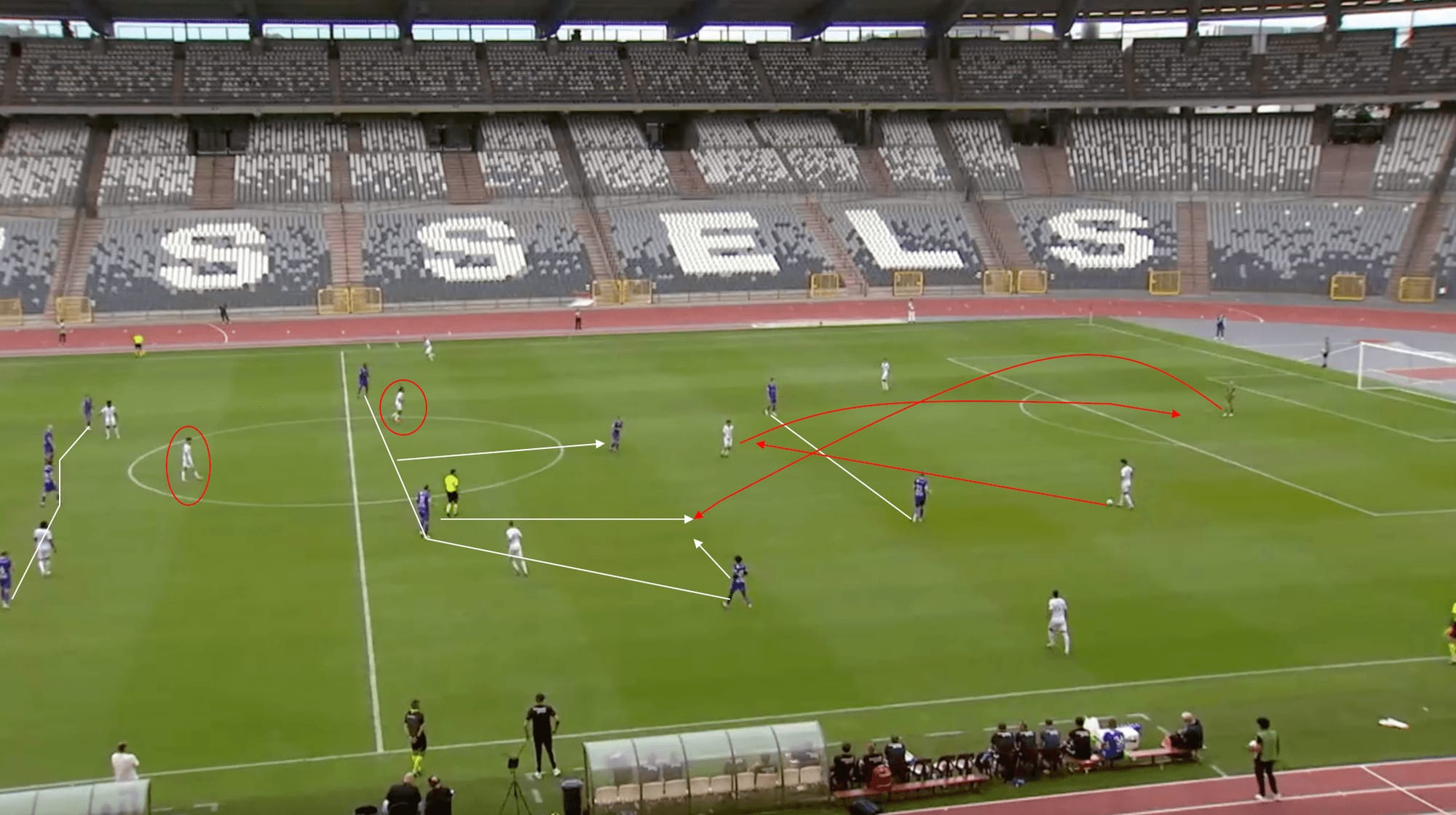
The image above shows another defensive phase for Patro Eisden, with the ball originating with the opposition centre-back. As was already covered, the Belgian side likes to keep the play in front of them, as illustrated above. With the lowest PPDA in the Challenger Pro League, it is no surprise that there is no immediate or incoming pressure on the Anderlecht II defender. We can also see how deep the Patro backline is, with them sitting well in their own half instead of near the halfway line.
They are also sitting in a midfield line of four and a front two. The ball from the central defender is played into the player positioned between the forward and midfield lines. Due to the early recognition, the Patro midfielder steps out of shape to engage, forcing him to play the ball back to the goalkeeper. The ‘keeper then plays into the midfield, with Patro Eisden pouncing on the ball and regaining possession.
As this section has shown, Stijn Stijnen’s Patro Eisden look to frustrate opposition sides out of possession with his defensive tactics of being compact and narrow, as well as keeping the ball in front, forcing opponent’s to play long and into the strength of the Patro Eisden back line.
Threat of attacking set pieces
Another thing Patro Eisden have excelled at this season is attacking set pieces, with the Belgian side scoring 7 (one penalty) out of their 11 goals off some sort of set piece. Whether it be a corner or free kick, Stijnen’s side have used this threat advantageously, with set pieces being a huge advantage if a team can excel at them.
Due to the nature of Patro Eisden’s style of play, as well as them being arguably one of the weaker teams in the Challenger Pro League, being able to excel at set pieces have helped the Belgian side punch above their weight so far this season.
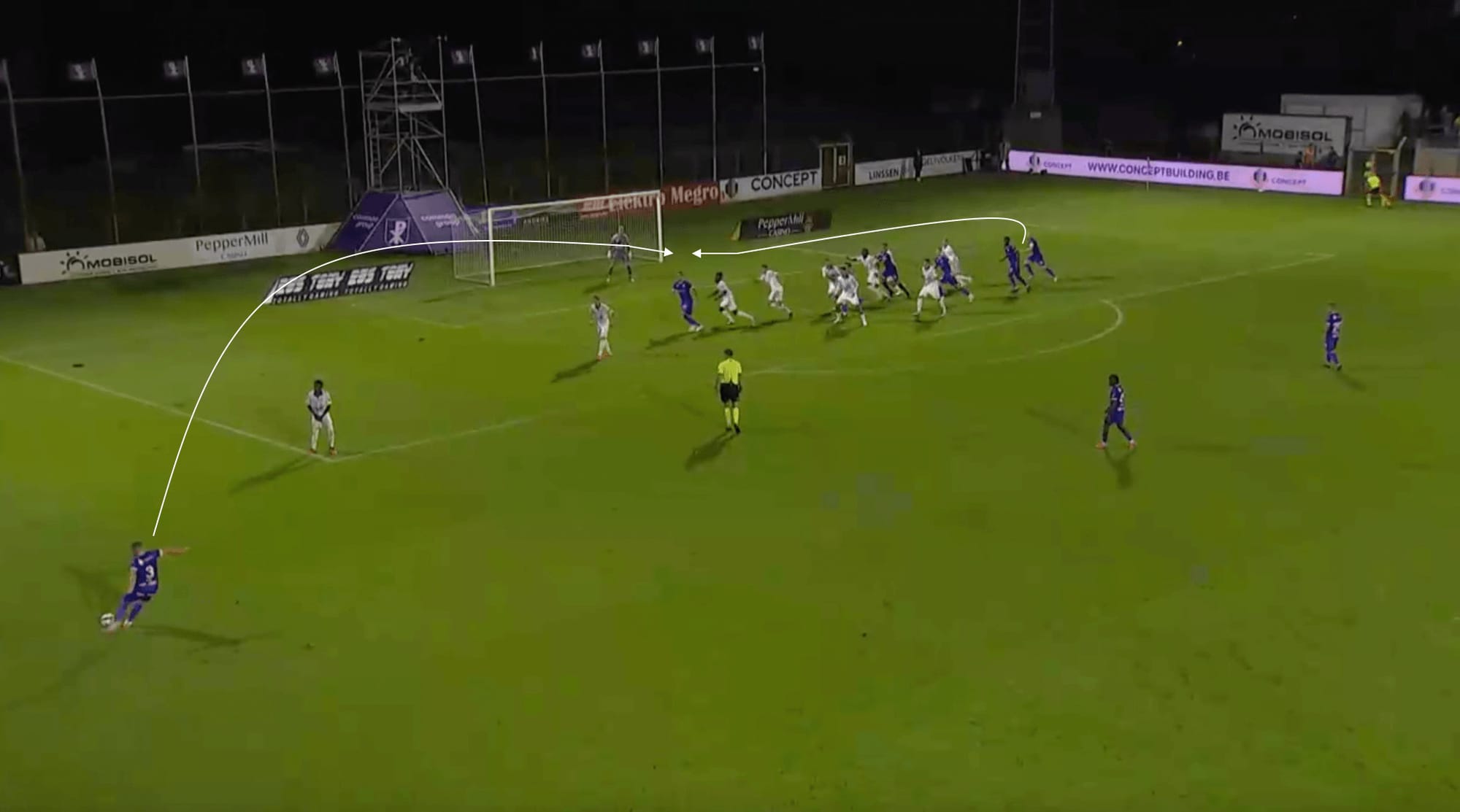
As mentioned, being able to excel at set pieces can be a significant advantage for sides that are considered on paper inferior to the opposition. In this phase of play above, Patro Eisden won a free kick in a pretty dangerous area against Beveren. The Belgian side set up to stack the back post, with four of the players in the wall towards the back post area. They also have two near the edge of the box to frame for a second ball.
Naturally, the intended target for the delivery is the back post area, and he is able to hit it with ease. The ball in from the fullback goes all the way towards the back post, with the goalkeeper having to get a hand on it to prevent it going straight into the net.
This slight touch redirects the ball into the path of the furthest player in the stack at the back post, with his first-time shot putting it in the back of the net, illustrating the deadly accuracy Patro Eisden’s set-piece takers have had this season, especially with over half of their goals coming from dead ball situations.
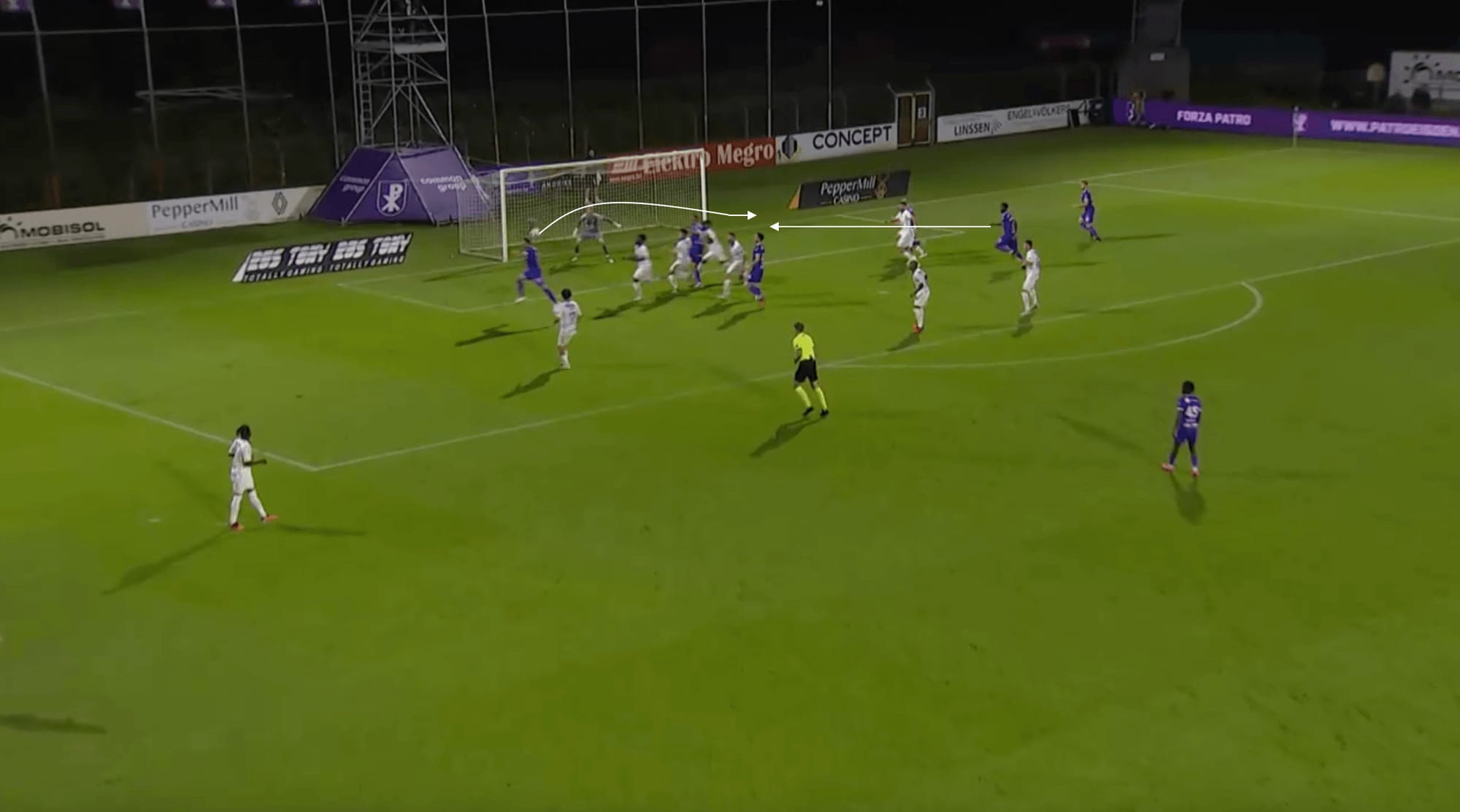
The image above shows another free kick goal scored by Patro Eisden, from essentially the same location as the first one against Beveren, and also at the back post. In this phase of play, the ball is again whipped in from the near touchline. However, this time, the ball reached the front post runner, who bent his run perfectly to get in front of the first defender.
His ensuing flick-on is perfectly weighted, with the ball falling right into the path of the onrushing runner at the back post. Again, the ball is put away at the back post, showing the strength of back post set pieces for Stijn Stijnen and Patro Eisden. With how successful they have been at set pieces in the early days of the season, this may be a considerable advantage if they are potentially fighting for promotion to the Belgian Pro League at the end of this current campaign.
Conclusion
As this tactical analysis and scout report has shown, Patro Eisden have had a fantastic start to the Challenger Pro League season after being promoted as the Belgian National Division 1 winners in the 2022/23 season. Stijn Stijnen has executed his tactics brilliantly so far, and if this can continue, they may find themselves in the Belgian Pro League in the 2024/25 season.





Comments